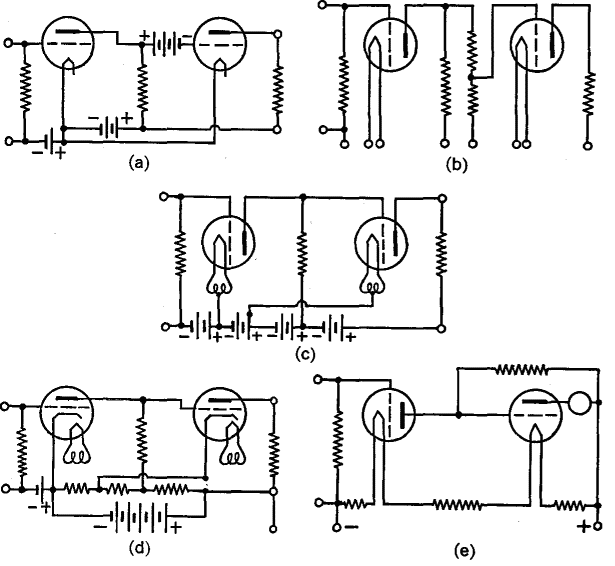| Basic Radio is a free introductory textbook on electronics based on tubes. See the editorial for more information.... |

|

Home  Amplifiers Amplifiers  Direct Current Amplifiers Direct Current Amplifiers  Multistage D.C. Amplifiers Multistage D.C. Amplifiers |
|||||
| See also: Multistage or Cascade Amplifiers | |||||






|
|||||
|
Multistage D.C. AmplifiersAuthor: J.B. Hoag It is also possible to amplify d.c. voltages with multistage amplifiers, as in Fig. 24 E.
In the Loftin-White circuit of Fig. 24 E (d), a common battery is used for the plate and grid voltages. The filaments of the two tubes are at different voltages and require care in insulation from the ground. In all multistage d.c. amplifiers, the voltage available for the power supply must be comparatively great.
In Fig. 24 F, the glow-tube G takes the place of the grid condenser of an R-C coupled amplifier and acts as a constant-voltage device even for currents as small as 10 micro-amperes (10-5 amp.) When Rg is 2 megohms (2 · 106 ohms), the drop produced by 10-5 amp. will be 20 volts. If Rc is chosen to give 30 volts, the net on the grid of tube 2 will be -10 volts. If the voltage at A changes, due to an input signal, the drop across G remains the same, but its current does change. Then the drop across Rg changes and is applied directly to grid 2. In other words, the circuit acts like an R-C coupled amplifier (see next chapter) with a leaky grid condenser which has the important characteristic that its voltage drop is always the same.
|
|||||
Home  Amplifiers Amplifiers  Direct Current Amplifiers Direct Current Amplifiers  Multistage D.C. Amplifiers Multistage D.C. Amplifiers |
|||||
Last Update: 2009-11-01



